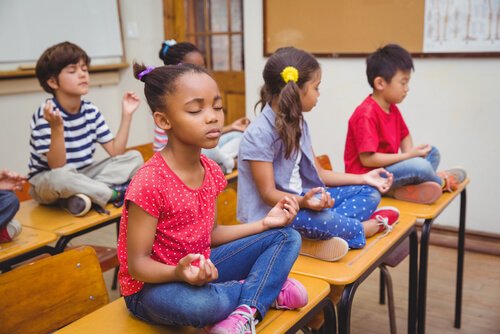The Benefits of Meditation in the Classroom

Children don’t feel as weighed down by prejudice, barriers and preconceived notions as adults. This is a great advantage when it comes to the practice of meditation. This activity also offers a wealth of advantages to students. That’s why we want to take a look at the benefits of meditation in the classroom.
First of all, it’s important to understand that meditation is both a mental exercise and a physical exercise. Students who put forth the required effort and give their full attention enjoy countless benefits. The benefits of meditation are both immediate and long term.
Meditation can fulfill an important role as part of regular teaching. It not only allows students to increase their self-awareness, but also change their perspective to some extent.
In fact, the practice of meditation only requires commitment. All you need is at least 10 minutes a day and a small space where you can sit down or stand up comfortably.
It’s also important to consider the fact that meditation isn’t just for adults Children and teens can also take advantage of this technique and enjoy all of its benefits.
Studies have even shown that meditation in the classroom helps students be more calm and focused. It also offers them the opportunity to learn to relax and reflect.
What are the benefits of meditation in the classroom?
Below, we’ll tell you more about the benefits of meditation in the classroom:
1. Improves focus
Meditation increases a person’s ability to concentrate during longer periods of time. Likewise, it teaches children that they have the ability to direct their attention.
This is advantageous for children in many ways. For example, students can pay attention longer during class and, consequently, better retain information.

2. Boosts compassion and self-esteem
Given that pressures and circumstances are out of their control, children often feel unable to pass certain tests. This can be difficult, especially when children suffer bullying or mistreatment from others.
Meditation can also reinforce feelings of security, empathy and internal stability in children. At the same time, it produces compassion, happiness and improved self-esteem in students.
3. Improves attention
Another one of the benefits of meditation we want to mention has to do with children’s ability to pay attention. Practicing meditation improves attention and reduces issues with internalization, such as fear, lack of integration in social groups, anxiety and depression.
In this sense, it improves children’s psychological well-being – a fact that’s supported by numerous studies.
4. Reduces stress
Meditation doesn’t only provide children with a much needed time of inactivity for physical, mental and emotional rest. It also directly affects the entire nervous system by reducing the chemicals related to stress, such as cortisol.
Meditation also decreases oxygen consumption, heart rate and blood pressure, as well as slows down breathing.
5. Improves memory
Memory allows children to retain more information, which, of course, is beneficial when taking different tests and exams.
A good memory also means a greater ability to combine several different thoughts and ideas at the same time. This is a useful ability when it comes to carrying on conversations and intelligent and interesting reasoning.

“Meditation increases a person’s ability to concentrate during longer periods of time. Likewise, it teaches children that they have the ability to direct their attention.”
6. Improves handling of emotions
Experts have firmly established the relationship between emotional imbalance and poor academic results. Fortunately, and as you’ve likely realized already, reduced stress and anxiety are another one of the benefits of meditation and the full attention that it brings us.
As if that weren’t enough, meditation also helps university students better handle their emotions. This has a positive effect on their academic performance.
Without a doubt, giving students time to be able to relax mentally is fundamental in improving behavior. Keeping in mind that children and youth are often under stress, meditation is a great way for them to gather and focus their thoughts.
Setting aside a designated time for stopping and meditating is positive on a number of levels. And not only for students, but for teachers as well. So, why not give this growing methodology a try?
Children don’t feel as weighed down by prejudice, barriers and preconceived notions as adults. This is a great advantage when it comes to the practice of meditation. This activity also offers a wealth of advantages to students. That’s why we want to take a look at the benefits of meditation in the classroom.
First of all, it’s important to understand that meditation is both a mental exercise and a physical exercise. Students who put forth the required effort and give their full attention enjoy countless benefits. The benefits of meditation are both immediate and long term.
Meditation can fulfill an important role as part of regular teaching. It not only allows students to increase their self-awareness, but also change their perspective to some extent.
In fact, the practice of meditation only requires commitment. All you need is at least 10 minutes a day and a small space where you can sit down or stand up comfortably.
It’s also important to consider the fact that meditation isn’t just for adults Children and teens can also take advantage of this technique and enjoy all of its benefits.
Studies have even shown that meditation in the classroom helps students be more calm and focused. It also offers them the opportunity to learn to relax and reflect.
What are the benefits of meditation in the classroom?
Below, we’ll tell you more about the benefits of meditation in the classroom:
1. Improves focus
Meditation increases a person’s ability to concentrate during longer periods of time. Likewise, it teaches children that they have the ability to direct their attention.
This is advantageous for children in many ways. For example, students can pay attention longer during class and, consequently, better retain information.

2. Boosts compassion and self-esteem
Given that pressures and circumstances are out of their control, children often feel unable to pass certain tests. This can be difficult, especially when children suffer bullying or mistreatment from others.
Meditation can also reinforce feelings of security, empathy and internal stability in children. At the same time, it produces compassion, happiness and improved self-esteem in students.
3. Improves attention
Another one of the benefits of meditation we want to mention has to do with children’s ability to pay attention. Practicing meditation improves attention and reduces issues with internalization, such as fear, lack of integration in social groups, anxiety and depression.
In this sense, it improves children’s psychological well-being – a fact that’s supported by numerous studies.
4. Reduces stress
Meditation doesn’t only provide children with a much needed time of inactivity for physical, mental and emotional rest. It also directly affects the entire nervous system by reducing the chemicals related to stress, such as cortisol.
Meditation also decreases oxygen consumption, heart rate and blood pressure, as well as slows down breathing.
5. Improves memory
Memory allows children to retain more information, which, of course, is beneficial when taking different tests and exams.
A good memory also means a greater ability to combine several different thoughts and ideas at the same time. This is a useful ability when it comes to carrying on conversations and intelligent and interesting reasoning.

“Meditation increases a person’s ability to concentrate during longer periods of time. Likewise, it teaches children that they have the ability to direct their attention.”
6. Improves handling of emotions
Experts have firmly established the relationship between emotional imbalance and poor academic results. Fortunately, and as you’ve likely realized already, reduced stress and anxiety are another one of the benefits of meditation and the full attention that it brings us.
As if that weren’t enough, meditation also helps university students better handle their emotions. This has a positive effect on their academic performance.
Without a doubt, giving students time to be able to relax mentally is fundamental in improving behavior. Keeping in mind that children and youth are often under stress, meditation is a great way for them to gather and focus their thoughts.
Setting aside a designated time for stopping and meditating is positive on a number of levels. And not only for students, but for teachers as well. So, why not give this growing methodology a try?
All cited sources were thoroughly reviewed by our team to ensure their quality, reliability, currency, and validity. The bibliography of this article was considered reliable and of academic or scientific accuracy.
- HLF. (n.d.). BRINGING MINDFULNESS TO THE COMMUNITY. Holistic Life Foundation. https://hlfinc.org/about-us/
- Vargas, M. (2010). La Meditación y la Relajación en la Educación. Hipnológica, 3, 22-23. https://www.hipnologica.org/wp-content/uploads/2019/11/La_meditacion.pdf
This text is provided for informational purposes only and does not replace consultation with a professional. If in doubt, consult your specialist.








